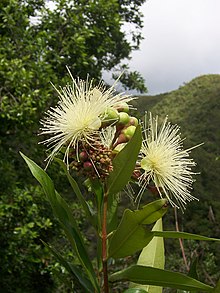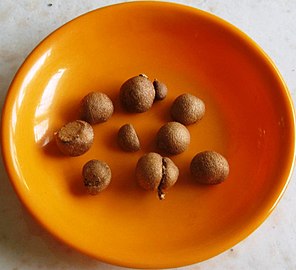Syzygium jambos
This article needs additional citations for verification. (September 2014) |
| Syzygium jambos | |
|---|---|

| |
| Scientific classification | |
| Kingdom: | Plantae |
| Clade: | Tracheophytes |
| Clade: | Angiosperms |
| Clade: | Eudicots |
| Clade: | Rosids |
| Order: | Myrtales |
| Family: | Myrtaceae |
| Genus: | Syzygium |
| Species: | S. jambos
|
| Binomial name | |
| Syzygium jambos L. (Alston)
| |
| Synonyms | |
|
Eugenia jambos | |
 Fruit and seeds. One fruit is split to show seeds. | |
| Nutritional value per 100 g (3.5 oz) | |
|---|---|
| Energy | 105 kJ (25 kcal) |
5.7 g | |
0.3 g | |
0.6 g | |
Niacin (B3) | 5% 0.8 mg |
| Vitamin C | 25% 22.3 mg |
| Minerals | Quantity %DV† |
| Calcium | 2% 29 mg |
| Iron | 0% 0.07 mg |
| Magnesium | 1% 5 mg |
| Manganese | 1% 0.029 mg |
| Phosphorus | 1% 8 mg |
| Potassium | 4% 123 mg |
| Sodium | 0% 0 mg |
| Zinc | 1% 0.06 mg |
| †Percentages estimated using US recommendations for adults,[2] except for potassium, which is estimated based on expert recommendation from the National Academies.[3] | |
Syzygium jambos is a species of rose apple originating in Southeast Asia and occurring widely elsewhere, having been introduced as an ornamental and fruit tree.[4]
Description
Syzygium jambos is a large
The fruit is shaped like some kinds of guava; in fact, the fruit is so like the guava in appearance that people unfamiliar with it may mistake it for a guava on sight. However, the fragrance, flavour and texture are different, and instead of containing dozens of small, hard seeds set in a jelly-like tissue, as a guava does, the fruit of S. jambos usually contains one or two large, unarmoured seeds about a cm in diameter, lying loose in a slightly fluffy cavity when ripe. Shaking a fruit to feel whether the seeds rattle, gives some indication whether it is ripe. The skin is thin and waxy. The flowers are described by some as fragrant, though this appears to be a variable attribute. The ripe fruit, however, has a strong, pleasant floral bouquet, hence such common names as "Rose apple"[6] and "pomarrosa".
Taxonomy
Botanical names
- Syzygium jambos
- Family: Myrtaceae
- Genus: Syzygium
- Species: jambos
- Synonym: Eugenia jambos
- Synonym: Jambosa jambos
- Synonym: Jambosa vulgaris
- Synonym: Myrtus jambos[7]
The tree has variously been allocated to the genus Jambosa, Eugenia[5] and Syzygium, where it now seems to have been permanently accepted. There have been a few species ascribed to it, but currently several varieties with various fruit colours all are recognised as Syzygium jambos.
Common names
Syzygium jambos has several common names, reflecting the large number of regions in which it occurs as a garden or fruit tree or as an invader. The names include ಪನ್ನೇರಳೆ , Guljamun , madhura nelli, Malabar Plum, Panineer Champakka, Mountain Apple (champoo), chom pu or chom-phu. Terms like "plum rose", "water apple", "pera de agua", "Cloud apple", "Wax apple", "Malay apple", "jambrosade", "PauTêe"(Penang Hokkien spelled with Taiwanese Romanisation System), "pomarrosa", or the English equivalent, "rose apple". Several of these names also are applied to other species of
In Myanmar, it is called Lily fruit (နှင်းသီး).
In the Philippines, it is locally called as yambo, dambo or tampoy.[4][8] Always confused with macopa, a closely related fruit (Syzygium samarangense), Syzygium jambos is not widely cultivated and can only be encountered in rural areas. It is the namesake of Lake Yambo, one of the Seven Lakes of San Pablo City, Laguna
In Maldives, it is called Jambu in Dhivehi, and its cousin fruit is called Jamburol, the water apple or wax apple.
It is also known as বগী জামুক Bogi Jamuk in Assamese.
In Brazil, the fruit is called jambo.
Varieties
There are many varieties of S. jambos worldwide, including nondescript feral trees. In Thailand the commonest cultivated variety bears a pale green fruit. Malaysian varieties generally have red skins. In many regions the fruit is a shade of pale yellow, often with a slight blush. The skin is thin and waxy, and the hollow core contains a small amount of insignificant fluff. The flesh is crisp and watery, and the taste is characteristic, which leads to some fanciful descriptions such as: "like a cross between nashi and bell pepper, with a very mild rose scent and a slightly bitter aftertaste."
Distribution and habitat
It has also been introduced widely on every continent except Antarctica, and it has become established and invasive in several regions. Concern has been expressed concerning the threat to several ecosystems, including those on several
Uses
Rich in vitamin C, the fruit can be eaten raw or cooked[10] in various regional recipes. In South-East Asian countries, rose apple fruit is frequently served with spiced sugar.
The wood is dense and accordingly is used as a source of charcoal.
The tree is variously rich in tannins that are of some antimicrobial interest. Some parts of the tree are used in regional traditional medicine.
References
- . Retrieved 19 November 2021.
- ^ United States Food and Drug Administration (2024). "Daily Value on the Nutrition and Supplement Facts Labels". Retrieved 2024-03-28.
- )
- ^ ISBN 978-0-85199-638-7
- ^ a b Chittenden, Fred J. Ed., Royal Horticultural Society Dictionary of Gardening, Oxford 1951
- ^ Hargreaves, Dorothy; Hargreaves, Bob (1964). Tropical Trees of Hawaii. Kailua, Hawaii: Hargreaves. p. 54.
- ^ Link text, additional text.
- ^ "Tampoi, Syzygium jambos (Linn.) Alston, ROSE APPLE, Pu tao / Philippine Medicinal Herbs / Alternative Medicine". www.stuartxchange.org. Retrieved 2017-03-09.
- USGS. Retrieved 26 February 2017.
- )
External links
 Media related to Syzygium jambos at Wikimedia Commons
Media related to Syzygium jambos at Wikimedia Commons- The Rose Apple
- USDA profile
- Invasive species
- Jambosier
- http://www.mpbd.info/plants/syzygium-jambos.php
- http://toptropicals.com/html/toptropicals/plant_wk/rose_apple.htm
- http://earthmedicineinstitute.com/more/library/medicinal-plants/syzygium-jambos/
- http://www.neifm.org/arunachalPage/showdetails/PLANT_ID/2032
- "Syzygium jambos". Plants for a Future.





